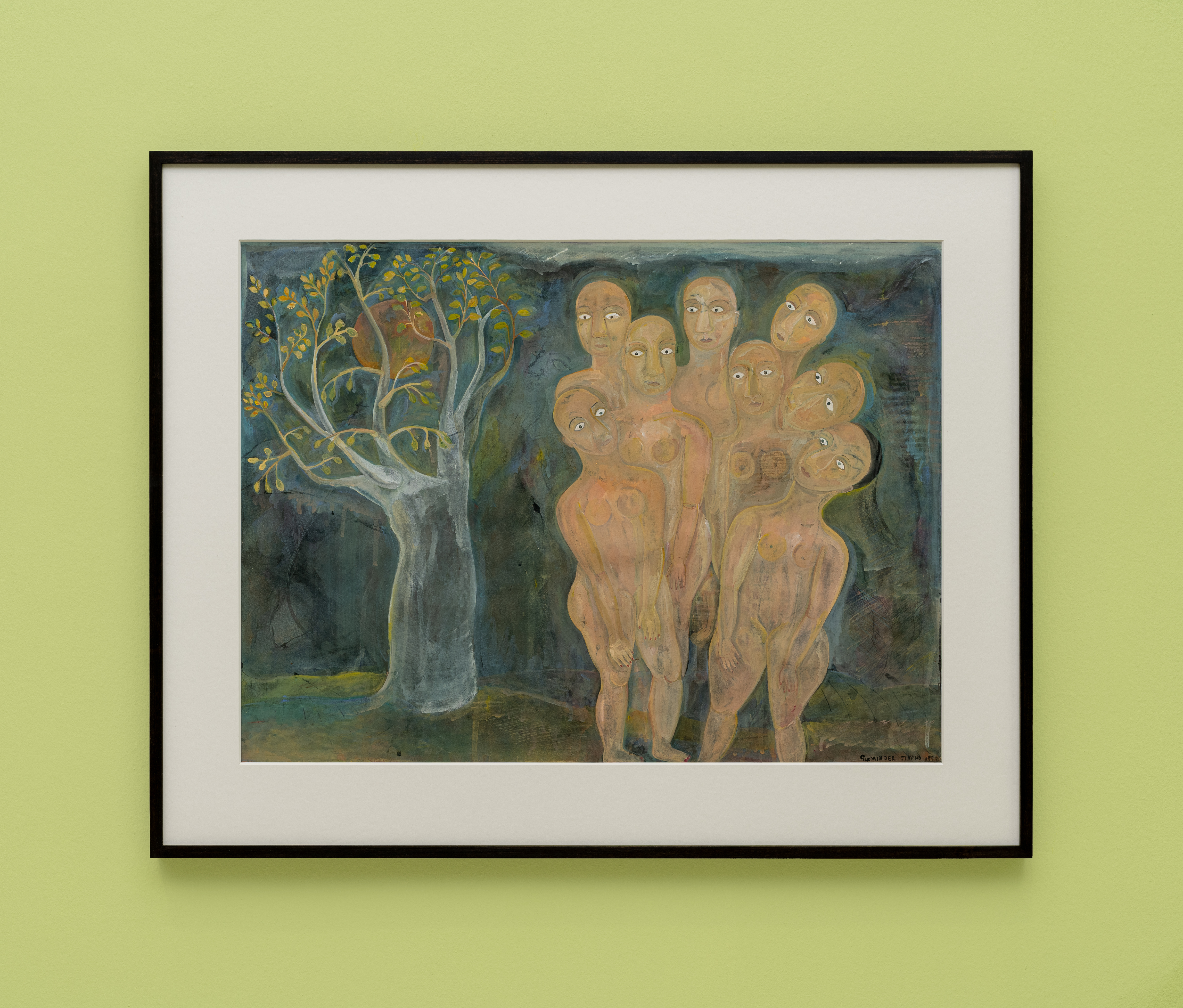


© Gurminder Sikand. Courtesy of the Estate of Gurminder Sikand and Maximillian William, London. Photography by Deniz Guzel.
Maximilian William Gallery
47 Mortimer St, London W1W 8HJ
The fusion of opposing forces —material and immaterial, western and non-western, strength and fragility— creates a hybridity which constitutes the character and identity of Gurminder Sikand’s ‘Early Paintings’. The exhibition, presented at Maximilian William Gallery, showcases a visual interplay of contrasting elements, both formally and conceptually, contributing to the depth and complexity which distinguishes the artworks on display.
Sikand, who was born in 1960 in Jamshedpur, Northern India, emigrated to Britain with her family in 1970. After moving to Nottingham, she graduated from Birmingham Polytechnic in 1983 and became a prominent figure among women artists of South Asian descent in the UK. Her paintings incorporate elements of the lands where she was born within the context of the English East Midlands. In addition to the inspiration from her Indian roots (including the flat colouring and edge-to-edge patterning of folk art and mother-to-daughter tradition of the Mithila region), Sikand also looked to Western painters such as Henri Matisse and Raoul Dufy for creative influence. As a result, her work combines Indian imagery and Hindu religious mythology with elements from the European modern tradition, embodying a postcolonial formal and conceptual hybridity. This ambivalence of cultural elements enhances the sense of hybridization in which she reveals a desire for belonging within the experience of migration and geographical/cultural displacement.
A series of medium and small-scale paintings depict muscular women’s bodies intertwined with sturdy tree stems, branches, and roots, sometimes blending with architectural elements or hints of houses within human heads. These components coexist as if in metamorphosis within dreamlike landscapes. The colour palette of the artworks tends towards brown, opacity, and darkness, evoking a connection to the earth. This contrasts with the light green walls of the gallery, which emphasises the importance of nature within the visual narrative of the series of paintings presented in the exhibition.
The juxtaposition of organic and architectural structures with the athletic forms of women’s bodies evokes a desire for 'grounding', highlighting the solidity and strength of both the female human body and Mother Earth. This is intertwined with an ethereal, transient quality of the forms and atmospheres, reflecting a hybrid of physical and psychological elements. The spectral nature of the characters and the elongated forms of the trees produce an otherworldly environment. The dark, indefinite backgrounds and fading shapes in the scenarios convey the intangible essence of emotions, thoughts, and desires, contrasting with the grounded stability of the elements previously noted. Within this suggestion of the intangible, the paintings somehow capture sensory qualities that transcend the visual realm, hinting at a sense of rootlessness amidst the overall theme of hybridity and transformation.
The female characters in the paintings are characterized by their striking eyes, which lack eyelids and feature black pupils at the centre of the sclera. These eyes convey a sense of detachment, appearing to be in an introspective or even hallucinatory state, detached from a specific focal point and out of the material world. The figures are furthermore depicted as complete bodies or amputated parts, such as floating heads - some without hair - or entities with multiple heads of varying sizes and orientations on a single body, like spirits. This suggests a juxtaposition of bodies across different temporalities, capturing a sense of multiple realities, almost psychotic or schizophrenic, within the image plane. However, these
figures contain references to Hindu symbolism and myth, especially to the multiple arms and heads of Kali, the blue Hindu goddess of creation and destruction. Opposing forces, once again, merge with one another, symbolising the duality of human and divine, good and evil.
This tension between the sense of rootedness and displacement reveals the emotional complexity of the artist’s personal experience of migration, but it also illustrates the conceptual intricacy of wider cultural hybridity produced by the tension between the East and the West. The concept of hybridity was discussed by the critical theorist Homi K. Bhabha, who talks about the colonial ambivalence, difference or adaptation, between Western and non-Western cultures, where colonial subjects are between both worlds.
Sikand’s work furthermore carries inherent political undertones, rooted in her involvement in the Chipko movement in the Himalayas. This movement saw women, including the artist Pamela Singh, coming together to embrace trees as a form of protest against industrial deforestation. The paintings, depicting the metamorphosis of women and trees, serve as a visual statement of resistance against the backdrop of environmental degradation during the 1990s. The connection between women’s bodies and trees is fundamental to her artistic research. This engagement is present within her practice as artistic activism as she advocated for the protection of the natural world.
The exhibition embodies a profound sense of intimacy and personal introspection. This series of ‘Early Paintings’, displayed at the Maximilian William Gallery, invites viewers into a hybrid interior in which the tension between the unstable desire to belong merges with a sense of confidence in knowing what it means and how it feels to be grounded. Through these paintings, Sikand presents an extraordinary vision that captures the complexities and contradictions inherent to human experience. The pieces beautifully navigate the tension between the external material world and the intricate, ambivalent realm of the human psyche and emotions.
Paula Zambrano
Curator of Programmes
Gurminder Sikand, 'Early Paintings' at Maximilian William Gallery
16 May - 29 June 2024